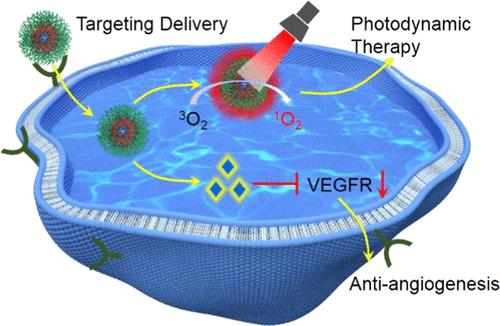当前位置:
X-MOL 学术
›
ACS Appl. Mater. Interfaces
›
论文详情
Our official English website, www.x-mol.net, welcomes your feedback! (Note: you will need to create a separate account there.)
Neuropilin-1-Targeted Nanomedicine for Spatiotemporal Tumor Suppression through Photodynamic Vascular Damage and Antiangiogenesis
ACS Applied Materials & Interfaces ( IF 9.5 ) Pub Date : 2024-04-23 , DOI: 10.1021/acsami.4c03886 Xin-Yu Li 1, 2 , Ni Yan 1 , Ye-Yang Wu 1 , Ren-Jiang Kong 1 , Zi-Wen Qiu 1 , Shu-Peng Liu 2 , De-Hua Wu 2 , Hong Cheng 1
ACS Applied Materials & Interfaces ( IF 9.5 ) Pub Date : 2024-04-23 , DOI: 10.1021/acsami.4c03886 Xin-Yu Li 1, 2 , Ni Yan 1 , Ye-Yang Wu 1 , Ren-Jiang Kong 1 , Zi-Wen Qiu 1 , Shu-Peng Liu 2 , De-Hua Wu 2 , Hong Cheng 1
Affiliation

|
Antiangiogenic therapy is an effective way to disrupt nutrient supply and starve tumors, but it is restricted by poor efficacy and negative feedback-induced tumor relapse. In this study, a neuropilin-1 (NRP-1)-targeted nanomedicine (designated as FPPT@Axi) is reported for spatiotemporal tumor suppression by combining photodynamic therapy (PDT) with antiangiogenesis. In brief, FPPT@Axi is prepared by utilizing an NRP-1-targeting chimeric peptide (Fmoc-K(PpIX)-PEG8-TKPRR) to encapsulate the antiangiogenic drug Axitinib (Axi). Importantly, the NRP-1-mediated targeting property enables FPPT@Axi to selectively concentrate at vascular endothelial and breast cancer cells, facilitating the production of reactive oxygen species (ROS) in situ for specific vascular disruption and enhanced cell apoptosis under light stimulation. Moreover, the codelivered Axi can further inhibit vascular endothelial growth factor receptor (VEGFR) to impair the negative feedback of PDT-induced tumor neovascularization. Consequently, FPPT@Axi spatiotemporally restrains the tumor growth through blocking angiogenesis, destroying tumor vessels, and inducing tumor apoptosis. Such an NRP-1-mediated targeting codelivery system sheds light on constructing an appealing candidate with translational potential by using clinically approved PDT and chemotherapy.
中文翻译:

Neuropilin-1 靶向纳米药物通过光动力血管损伤和抗血管生成抑制时空肿瘤
抗血管生成治疗是破坏营养供应和饥饿肿瘤的有效方法,但其效果不佳且负反馈导致肿瘤复发,因此受到限制。在这项研究中,报道了一种靶向神经毡蛋白-1 (NRP-1) 的纳米药物(称为 FPPT@Axi),通过将光动力疗法 (PDT) 与抗血管生成相结合来抑制时空肿瘤。简而言之,FPPT@Axi是利用NRP-1靶向嵌合肽(Fmoc-K(PpIX)-PEG 8 -TKPRR)封装抗血管生成药物阿西替尼(Axi)而制备的。重要的是,NRP-1介导的靶向特性使FPPT@Axi能够选择性地集中在血管内皮细胞和乳腺癌细胞上,促进原位活性氧(ROS)的产生,从而在光刺激下破坏特定的血管并增强细胞凋亡。此外,共递送的Axi可以进一步抑制血管内皮生长因子受体(VEGFR),从而削弱PDT诱导的肿瘤新生血管形成的负反馈。因此,FPPT@Axi 通过阻断血管生成、破坏肿瘤血管和诱导肿瘤细胞凋亡来在时空上抑制肿瘤生长。这种 NRP-1 介导的靶向共传递系统有助于通过使用临床批准的 PDT 和化疗来构建具有转化潜力的有吸引力的候选药物。
更新日期:2024-04-23
中文翻译:

Neuropilin-1 靶向纳米药物通过光动力血管损伤和抗血管生成抑制时空肿瘤
抗血管生成治疗是破坏营养供应和饥饿肿瘤的有效方法,但其效果不佳且负反馈导致肿瘤复发,因此受到限制。在这项研究中,报道了一种靶向神经毡蛋白-1 (NRP-1) 的纳米药物(称为 FPPT@Axi),通过将光动力疗法 (PDT) 与抗血管生成相结合来抑制时空肿瘤。简而言之,FPPT@Axi是利用NRP-1靶向嵌合肽(Fmoc-K(PpIX)-PEG 8 -TKPRR)封装抗血管生成药物阿西替尼(Axi)而制备的。重要的是,NRP-1介导的靶向特性使FPPT@Axi能够选择性地集中在血管内皮细胞和乳腺癌细胞上,促进原位活性氧(ROS)的产生,从而在光刺激下破坏特定的血管并增强细胞凋亡。此外,共递送的Axi可以进一步抑制血管内皮生长因子受体(VEGFR),从而削弱PDT诱导的肿瘤新生血管形成的负反馈。因此,FPPT@Axi 通过阻断血管生成、破坏肿瘤血管和诱导肿瘤细胞凋亡来在时空上抑制肿瘤生长。这种 NRP-1 介导的靶向共传递系统有助于通过使用临床批准的 PDT 和化疗来构建具有转化潜力的有吸引力的候选药物。



























 京公网安备 11010802027423号
京公网安备 11010802027423号